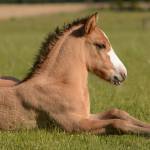Vitamin E Deficiency and Central Nervous System Damage in Foals

Vitamin E, an essential fat-soluble nutrient, protects foals that are at risk of developing the neurologic disease known as equine neuroaxonal dystrophy (eNAD). According to new research, even foals not susceptible to eNAD can show evidence of damage to central nervous system tissues if deprived of vitamin E in the first six months of life.*
Typically occurring in young horses less than two years of age, eNAD is characterized by spinal sensory tract damage of the central nervous system, which manifests as incoordination. Past research has determined that eNAD has a genetic component, frequently occurring in families.
“When susceptible foals born from mares with eNAD are supplemented with vitamin E, the prevalence of eNAD is significantly reduced. Thus, both genetic susceptibility and vitamin E deficiency are thought to contribute to the clinical development of eNAD,” said Catherine Whitehouse, M.S., a Kentucky Equine Research nutrition advisor.
Testing for eNAD in live horses is challenging. One test that may be used involves measuring a protein called phosphorylated neurofilament heavy (pNfH) in cerebrospinal fluid. This protein is released into cerebrospinal fluid when the axons of nerve cells are damaged.
Because this test is still in development, veterinary researchers wanted to know what happens to pNfH levels in cerebrospinal fluid early in the lives of foals genetically susceptible to eNAD. They also wanted to measure pNfH levels in the cerebrospinal fluid of eNAD susceptible and nonsusceptible foals in the face of vitamin E deficiency.
Three groups of foals were studied: those genetically susceptible to eNAD subjected to vitamin E deficiency; healthy foals subjected to vitamin E deficiency; and healthy foals supplemented with vitamin E.
Over the course of the first six months of the foals’ lives, on days 30, 60, and 180, cerebrospinal fluid was collected from each group of foals and pNfH was measured.
“As expected, pNfH levels were elevated in vitamin E depleted foals with a genetic susceptibility to eNAD. Also, pNfH levels were elevated in healthy foals that were vitamin E depleted early in life. This suggests that vitamin E deficiency early in life alone may also cause nerve damage even if those foals do not develop eNAD,” explained Whitehouse.
According to Whitehouse, “Supplementing pregnant and lactating mares with aqueous, natural-source vitamin E is an effective way of increasing vitamin E status in foals.”
This is particularly true for mares maintained on hay-based diets or those with a history of low vitamin E status. Nano-E is a highly bioavailable source of vitamin E that uses nanotechnology to ensure rapid absorption.
*Donnelly, C.G., and C.J. Finno. 2022. Vitamin E depletion is associated with subclinical axonal degeneration in juvenile horses. Equine Veterinary Journal. doi.org/10.1111/evj.13907.








